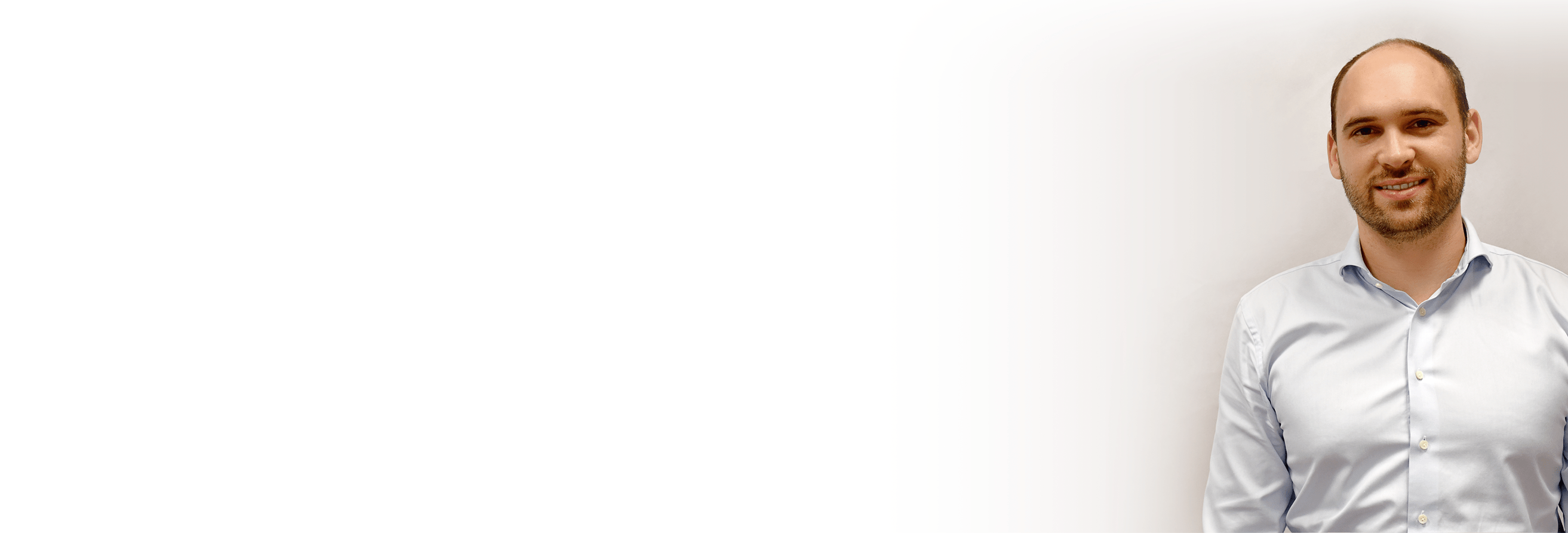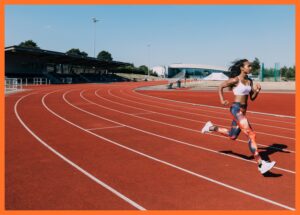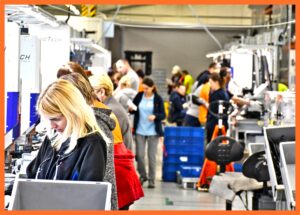ENGINAIRS: Interview with Jakub Jęśkowiak
Is the spare tire the “3rd wheel” of the car? What is the recipe for success at Aircom for a young designer (and why is it courage), as well as who is using an elephant gun to kill a gnat, will all be told by experienced engineer Jakub Jęśkowiak, Product and Industrial Engineering Team Manager at Aircom.
You came to Aircom right after finishing your studies.
Basically yes. During my studies, I did some internships. Right before Aircom, I worked in a company (among others) producing furniture and steel elements for shopping malls. I decided that designing furniture and clothes hangers was not what I wanted to do in my life (laughs). I found Aircom thanks to my roommate at the time, who had received a job offer from the company. He wasn’t available, but I was (laughs). And so began my adventure at Aircom.
You started work in 2014.
Yes, these were the first years of Aircom in Poland. At that time, we only had one production line here, the first premium compressor model for the VW Group. It was the time when we were also finishing the high performance compressor for Porsche Cayenne and VW Touareg. Since then, a lot has changed at Aircom starting from the number of people working in 2014 and today. This number has at least tripled, and the size of the production hall is now twice as large. Certainly, it was more intimate back then. Basically, all of the production employees knew each other by name. We also did not have such laboratory equipment and tools as we do now. We had to really use our heads to verify our design assumptions with the resources we had then. But in spite of everything, sometimes such old school methods of building prototypes did the trick and gave us twice the satisfaction. It is now easier and faster. We have various measuring instruments, test stands, 3D printers and CNC machine tools that help us develop products more efficiently.
What have been some of the turning points in the development of the company during your more than five years here?
The start of production of the first generation premium compressor was a milestone in the development of Aircom, as it ensured stable financing of subsequent investments. The next important stage was the implementation of a new generation of this same product. This smaller, lighter, more efficient, and cost-effective compressor has helped the company gain half of the European market. In my opinion, the new premium compressor is the best product in terms of technology, taking into account the worldwide competition. Due to its great dimensions, performance, and weight, it seems to be a product that sells itself. The new premium compressor goes beyond the specifications of our client, the VW Group. Following our motto, define the standard, we constantly do more than the customer expects from us.
How long has it taken us to reach (and even go beyond) the guidelines that the client has presented to us?
We gain experience with each completed project, which allows us to save time when building new products. It depends whether the product is the next generation of the existing device or whether we are developing something completely new. If we rely on an existing structure, analyze it, and improve individual areas, then it takes us about a year. However, creating a completely new product – such as a compressor for lifting seats – requires more work, approximately 2 to 3 years.
Who was the originator of our first compressor?
That compressor was created by Polish engineers in Pietrzykowice, whose work was coordinated by Mr. Straub. It can be said that he is our teacher and the person who had the greatest impact on the shape of this product. Currently, Mr. Straub acts as an expert and consultant who makes various corrections and provides valuable tips. He is the father of the development department at Aircom.
Knowledge is not everything for a designer. If you understand the laws of physics, mechanics, and mathematics well, that’s great, but theory is not enough. You need practice, and Mr. Straub is an extremely experienced engineer. I was fortunate that he personally introduced me to arcana of compressors at the beginning of my career at Aircom. Mr. Straub is a very demanding teacher who is worth listening to. The experience he shares bears fruit in our construction work. Cooperation with him allows us to become independent and develop professionally.
How do you assess Aircom’s position in the global automotive market?
There is a noticeable slowdown in the industry. I am thinking, for example, of Germany, which is our main market. In the face of a possible crisis, the automotive industry is one of the first to feel the effects. During an economic slowdown, both companies and society start to save money. Although the sale of new cars may fall at such moments, which does affect the supply of OEM repair kits, our new customers make up for any losses. And Aircom is a company that has a thriving Sales department and RnD Department that provide new solutions for the market. Because of this, we are constantly gaining new markets, not only in Europe, but also in Asia.
Besides that, we are entering the retail market.
That’s right. This is another market segment that we will develop. I see a great opportunity for development here. In times of crisis, the individual customer market can be a real source of revenue because people prefer cheaper (as well as lighter and more effective) solutions, i.e. a repair kit instead of a spare tire. Let’s remember that our sets have been driving around in new car models for several years, and now customers will be able to buy exactly the same set – either the compressor itself or with the sealant – as a separate product.
Another opportunity for Aircom is entering the Chinese market. It is a market as powerful as the entire European market. So I think Aircom’s vision of crisis is not a threat. We are at such a stage of the company’s development that no economic slowdown can stop us – if it even happens at all (laughs).
So you see a bright future for repair kits (laughs).
Definitely! From the designer’s perspective, it is impossible not to notice that thanks to the kit, we save space in the car. We get rid of the big spare tire which limits the capacity of our trunk. Both elements of the set, i.e. the compressor and sealant, weigh significantly less than the tire. This solution is more technically efficient, as well as cheaper to produce, because of which the price of the car is also more affordable for the end-user.
In turn, from the user’s point of view, such a solution is extremely convenient. A person who has never changed a tire before might not cope with such a challenge – even more so in a stressful situation. Besides, research supports this claim. Emergency situations usually occur suddenly. The user stops the car wherever they can, not where they want to. So they park, for example, on an unpaved roadside, where using a jack to change a tire can be dangerous. As well, changing the tire yourself involves the use of considerable physical strength, even more so if the screws are rusted.
The alternative is our repair kit. We take it out of the car, connect it to the cigarette lighter socket on one end, and to the tire on the other, and turn on the device. After about 10 minutes, the tire is sealed. We follow the instructions (or application), seal the tire, return the set to the trunk – and it’s ready! We don’t have to do anything else – we can continue driving. This is definitely a much easier option for the average user than changing the entire tire.
The next aspect is the environmental aspect. The impact of the set on the natural environment is significantly lower than a spare tire. The weight of the compressor with the sealant is several times lower and translates directly into the reduction of carbon dioxide emissions.
Will the spare tire become a luxury product in the near future or will it be completely supplanted by the market?
It all depends on the tastes of the users. They shape the market. So if the demand for spare tires does not decrease, they will certainly still be included with new cars. However, due to the previous arguments, I see that the global trend is quite the reverse. OEMs are adding a spare tire to their cars at the factory less and less. This is because digitization has been going on for years, with cars having more and more electronics and additional devices, while the vehicle’s size remains more or less the same. Engineers are constantly looking for additional space. There were also so-called folding wheels – we use them e.g. in our test Touareg. It is obvious that the industry is looking for a solution in this field, and the spare tire is actually the “3rd wheel” on the car (laughs).
And here our set appears as an alternative. A revolutionary solution because we suddenly gain a lot of space in the whole car!
As a head of the design department, you are constantly learning.
In the thicket of my current duties, I have little time for additional training which is why I try to absorb knowledge primarily from the afore-mentioned Mr. Straub. He eventually created the RnD department at Aircom. I often bring various challenges home and try to solve them after hours. One senior designer once told me that engineering work is not the easiest one because of the fact that various challenges and puzzles are often brought home. I am a person who will not rest until he finds a solution to a bothersome problem – which is sometimes quite annoying to me (laughs). I look for knowledge using conventional sources – literature, the Internet. I also get advice from experienced colleagues. What is worth emphasizing is the appropriate research attitude, inquisitiveness, and willingness to thoroughly examine the issue. Only with this attitude can we expect that the answers to the questions will basically appear on their own. When we analyze every aspect, every detail of the problem, we can come to valuable conclusions. The devil is in the details!
The fact that we have a real RnD department – and I know there are not many of them in the area – allows us at Aircom to conduct research from concept to implementation on the production line, and thus gain extensive experience within the walls of one company. I think that this is the competitive advantage of both our company and us as professionals. Since I participate in the recruitment process for my department, I have noticed the gap between our engineers and candidates who come to us from other companies. People of the same age, at the same universities, working with us know a lot more and are able to do much more, independently, than employees of competing companies.
This is an advantage resulting from the location of the RnD department inside the company structure. Current trends are quite different globally – many services are externally located. Basically, everything is outsourced and the company only assembles ready components. We are swimming a little against the current in this area and such a policy brings measurable benefits. We test our concepts in laboratories, and we build equipment for production lines ourselves and finally produce inhouse. This teaches us a cross-sectional view by visualizing various design challenges at every stage of product development.
During our conversation, you have said sometimes directly and sometimes between lines what the company can give to both a beginner and an experienced constructor. I would like to ask you now what the designer should do in order to find their way to our organization.
If you work in a real RnD department, the ability to use software is just a form of using a tool. It’s like a blacksmith having a black hammer and a green hammer. Knowledge of software is the skill of a draftsman, i.e. the level of technician. Software is not the most important thing in RnD. Good technical fundamentals in physics and mathematics matter. An analytical approach to the problem, which I mentioned earlier, is also the key to the success of the constructor. It is important to switch to some kind of creative mode – this is probably the most important skill that we expect from new employees. Why? Well, after graduation, a green engineer graduates with various limitations. At the Polytechnic we get to know – I also speak as a graduate – the only right approach to the problem. We learn to make patterns. And using the schemes, we can make at most average products – which, after all, we do not want at Aircom because we are aiming for market success. The academic approach is OK as long as it is complementary to a comprehensive analysis that is not afraid to ask even the most unusual – or just creative – questions. You need courage. The designer cannot be afraid to ask questions, challenge current achievements – sometimes he has to do something differently than the others. This does not mean, of course, that everything should be done contrarily. I am just saying that it is sometimes worth it to deviate from the path chosen in advance.
In the vicinity of Aircom headquarters, there are many design offices where engineers work on client guidelines and constitute a certain tool. On the other hand, you attach importance to independent thinking and creativity in your team. Is there a happy medium, some golden ratio between university expertise plus software knowledge and the open research approach you’re talking about?
I do not know such a golden ratio. But I will venture to say that the recipe for success in the RnD Aircom department is: 50% creativity, 40% technical basics and knowledge, and 10% use of tools such as Excel or some CAD.
Sounds very non-standard, taking into account the conditions of the local labor market in our industry!
That’s a fact. However, look – if you don’t do conveyor belt production in a small series, then CAD knowledge is really not a primary skill. Remember that at Aircom, we run product development, so we work long-term, sometimes in a perspective of a few years. Observations, comments, and tests are more important. You will find a designer here with a sparkle in his eye who will be looking forward to the next day of experiments and their verification. Such people are the most often successful!
We have established that universities only partially prepare the graduate to achieve professional success. And how does business cooperation with polytechnic universities look in your experience?
Well, I have had some experience in business cooperation with universities. I had the impression that universities, searching for answers to our questions, were using an elephant gun to kill a gnat. We once needed help with calculations because we did not have software to carry them out. I went to my former professors and asked them for help. They said it was no problem. However, the price they requested for this service was horrendous, and the scope of additional tests allegedly necessary to perform them was completely disproportionate to our needs. It turned out that commercial companies for the same service can offer a price almost twice lower!
Another issue is the pace of work of researchers. We once met with professors to propose the concept and modernization of certain production areas at Aircom. However, the deadline set by the university for the implementation of the concept hit the deadline we had set for production implementation! I do not want to judge, maybe this delay results from other scientific burdens that I do not know about. However, the fact is that commercial companies are simply faster and cheaper.
Local universities lack a market approach. I may be wrong, but I think our academies can’t keep up with industry. In the west, colleges are the forefront of progress. They initiate innovations, stimulating industry to act. I get the impression that in this part of Europe, it is quite the opposite. Of course, I’m generalizing a bit. There are certainly examples of exemplary cooperation between universities and business. However, my experience to date leads to rather clear conclusions.
So do you see any way to bring university and business closer together?
I cannot make a clear diagnosis as to why things are the way they are. Perhaps the reason is the lack of resources necessary for research. I’m not saying that there are no valuable, extremely talented people at Polish universities – on the contrary, I think there are plenty of them! I think it is rather a systemic issue.
At Aircom, we were thinking about internship programs that would enable a faster start for new engineers. The first year of work for a new employee is actually mainly just learning. The engineer begins to bring real benefits to the company only after this time. During this first year, there is a risk that such a person may not like something – and we start the whole process from the beginning.
Returning to my post-graduate degree – people from industry came to the classes and shared their knowledge with us. They were prominent people: presidents, board members from the industry. They talked about the daily work mode, the various challenges that each new day set for them. And these lectures constituted, in my opinion, a significant value of my studies! It is only in collision with market reality and practice that the student takes on vigor and sees a broader perspective for development. These testimonies opened our eyes.
Of course, universities are essential. The technical basis – knowledge of the laws of physics, mathematics, mechanics, the ability to perform calculations, and logical thinking – which students acquire, is the absolute foundation of the work of a designer. In this case, Wroclaw University of Technology proves itself 100%.
Kuba, at the end tell me, what you do outside of work when you manage to carve out some free time in your extremely active professional life?
Well…I’ve recently got involved in the guitar. I started two years ago with acoustic. But I’ve been playing electric guitar for several months. I have a Fender Stratocaster. I have to say I really got into it (laughs). It is a great escape from work for me! Such playing in the evening totally relaxes my mind and makes me feel good the next day.
This is a paradox because although I still lack a lot of skills, I am a two-time Guinness world record holder (laughs). As you probably know, the Guinness guitar-playing world record is broken every year in the Wroclaw Market Square in May. I try to participate in this event regularly. I have been doing it for 3 years. There is an interesting story associated with this event. Well, I bet my dad that I would learn the chords for the song “Hey Joe” by Jimi Hendrix in a week. These were my beginnings with the guitar. I worked hard, practiced painstakingly, but the effect did not satisfy me after all. I did receive the certificate, but it was then that I decided to buy my first guitar and start diligently learning how to play.
Do you compose or play covers?
Rather, I try to play already existing songs. I assume that first I have to learn to play, and then I can throw myself into deep water and start composing. Red Hot Chili Peppers come out best for me because I like this band, and I know their songs well. Their guitarist, John Frusciante, played the same guitar that I have.
My dad is a pretty good guitarist and once tried to transfer his passion to me. I was probably 10 years old at the time, and I was a bit discouraged by the chords that were just too complicated – especially F-major (laughs). So, I had to mature a little because a dozen or so years after the first attempts at the guitar, I never get bored with this passion.
Can you finally play this F-major now?
Now I can with no problem! (laugh)






